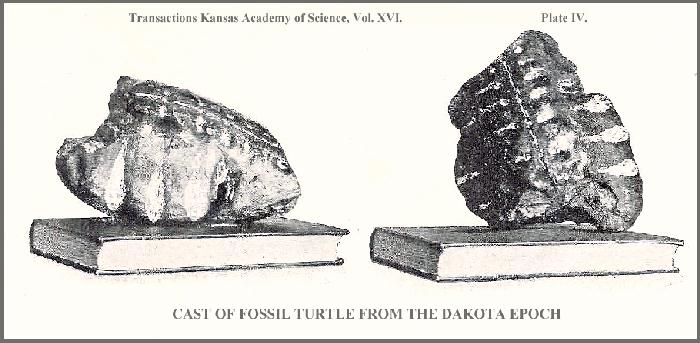
Parmenter, C. S.
1899
Fossil turtle cast from the Dakota Epoch
Kansas Academy of Science, Transactions 16:67
Copyright © 2004-2009 by Mike Everhart
ePage created 06/25/2005; Last revised 09/07/2009
LEFT: Plate IV from Parmenter (1899)
Wherein C. S. Parmenter describes the cast of a fossil turtle from the Dakota Sandstone (Cenomanian) of Cloud County. From a review of the photographs that were published (above), it is far more likely that the specimen represents the sacrum of an ankylosaur such as Silvasaurus. Unfortunately, the specimen was subsequently lost.
|
GEOLOGY AND PALEONTOLOGY.
67
FOSSIL TURTLE CAST FROM THE DAKOTA EPOCH. BY C. S. PARMENTER, BALDWIN.
The fossil cast here represented by a plate was presented to Baker University by Rev. O. K. Jones, an alumnus of Baker University, class of 1876. The specimen was given to Mr. Jones by a resident of Cloud county, whose name I have been unable to ascertain. Mr. Jones says, in a letter to myself: "The specimen was found south of Concordia, on a divide. The formation is red sandstone, which outcrops in ledges and lies scattered allover the ground in places. The specimen was secured not far from the north line of Ottawa county, on one of the spurs facing south, just north of what is called the Bethel neighborhood, thus fixing without doubt the geological position of this fossil. The fossil cast is composed of the characteristic hard, red sandstone of the Dakota group. Its maximum length is eleven and one-half inches. Its maximum width is nine inches. The dorsal aspect is very much more convex than the ventral and bears the well-defined impressions of the flattened portions of ten ribs. Along the line of the backbone there are the indentations of the proximal ends of fourteen ribs. A deep constriction is found four inches from one end and another evidently existed at the other. In the report of the United States Geological Survey of the Territories, Vol. II, page 16, E. D. Cope, in speaking of the rocks of the Dakota epoch, says: " No vertebrate fossils have yet been obtained from them." In the University of Kansas Geological Survey, Vol. IV, Doctor Williston says: “No vertebrate remains of any kind have so far been discovered either in Kansas or elsewhere, save impressions or casts. A record of footprints from this formation was first made by Prof. B. F. Mudge in 1866, and later one by Prof. F. H. Snow." This fossil, then, makes the third evidence of vertebrate life found in the Dakota epoch and the first and only fossil cast showing something of the structure of the animal. It is therefore unique and of great interest to students of paleontology. |
Suggested references:
Carpenter, K., D. Dilkes, and D. B. Weishampel. 1995. The dinosaurs of the Niobrara Chalk Formation (upper Cretaceous, Kansas). Journal of Vertebrate Paleontology 15(2):275-297.
Cope, E. D. 1875. The Vertebrata of the Cretaceous formations of the West. Report of the U. S. Geological Survey Territories (Hayden) 2:302 p., 57 pls.
Eaton, T. H. Jr. 1960. A new armored dinosaur from the Cretaceous of Kansas. University Kansas Paleontology Contributions 8:1-14, 2 fig. (Silvasaurus)
Mudge, B. F. 1866. Discovery of fossil footmarks in the Liassic (?) Formation in Kansas. American Journal of Science, Series 2, 41(122):174-176.
Snow, F. H. 1887. On the Discovery of a fossil bird track in the Dakota Sandstone. Kansas Academy of Science, Transactions 10:3-6.
Williston, S. W. 1898. Birds. The University Geological Survey of Kansas, Part II, 4:43-53, pls.5-8.